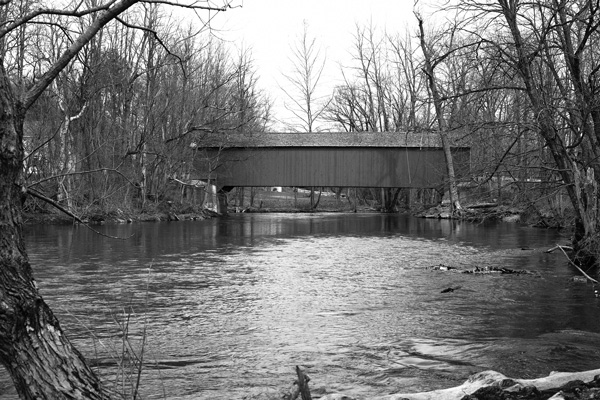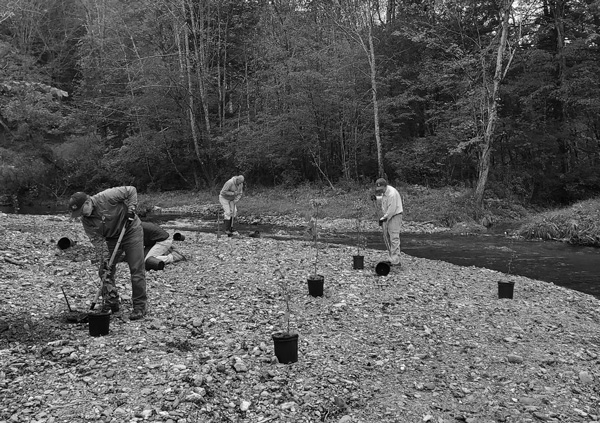News & Issues April 2022
Restoring the Batten Kill watershed
Groups band together to protect a river famous for its wild trout

The Batten Kill rushes under a covered bridge in the hamlet of Eagleville, N.Y. Photo by Joan K. Lentini.
By DON LEHMAN
Contributing writer
SALEM, N.Y.
A man snorkeling in a shallow pool of water in remote Camden Creek is not a regular sight. You are more likely to see a cow in the creek than a human, let alone someone with a camera snorkeling its pools.
But there was Jacob Fetterman, project coordinator for a new effort to restore and improve the Batten Kill watershed, face down in the creek looking for trout one day last July.
His outing was captured on video, and he found what he had hoped to see: numerous small trout in sections of the creek that Fetterman and a team of volunteers had recently worked to improve. The group restored the creek to its historic channel, fixed failing stream banks and added tree root balls for fish to use as cover from predators.
“That was very exciting,” Fetterman said. “It was great to see trout using the habitat we created for them.”
Fetterman, a fisheries biologist, works for Trout Unlimited, a nationwide organization that advocates for coldwater fisheries that are or were home to trout. Trout Unlimited, known as TU to its members, has put millions of dollars into projects around the country to repair problems in and around waterways, most of them caused by humans.
The Batten Kill and its tributaries have been renowned for generations for their brook trout and brown trout fishing. But in the 1990s, anglers noticed that the numbers of trout had dropped precipitously.
The reasons have been debated, but what became clear was that changes to the river from development, removal of wood debris, flooding and other human-related factors had diminished the habitat for trout. With fewer places to hide, fish were more susceptible to predation. Changed river channels caused the water to get warmer in the summer, affecting the fishes’ ability to survive the heat.
Repairing a watershed
In the early 2000s, Trout Unlimited’s local chapters in eastern New York and southwestern Vermont began work with the Battenkill Watershed Alliance, a number of other volunteer groups and state and federal fisheries agencies to try to address the root causes of the watershed’s problems.
More than 50 projects in New York and Vermont resulted. Natural wooden structures and rocks were added in places, and the river channel was narrowed in areas to improve aeration and flow, slow erosion and keep water temperatures cooler, as preferred by the coldwater-loving trout. This also improved habitat for native aquatic insects, turtles, crayfish and many other wildlife species.
These efforts to restore the river and rebuild aquatic habitat in Vermont and New York resulted in noticeable increases in trout populations in some parts of the Batten Kill.
On one section of river in western Vermont, an examination before a round of habitat work in 2017 found just three adult fish and a few younger trout. When surveyors returned months after the work, the new habitat areas held 76 adult trout and 60 young fish.
While these improvements were heartening, the local Trout Unlimited volunteers believed more work was needed. So they petitioned TU’s national organization to begin a yearslong “Home Rivers Initiative” project in the watershed, overseen on site by a coordinator from the national group. Enter Fetterman.
Funds needed to be raised for the project before Trout Unlimited would OK it. The national organization gave the go-ahead in late 2019 after local supporters raised $160,000 from private and public sources and in-kind contributions.
Despite the arrival of the Covid-19 pandemic, work around the watershed began after a streamwide assessment in the spring of 2020. Now, with nearly two years of projects under their belt, local advocates say they’re pleased with the results.
“We are very happy with the work that has been done so far,” said Cynthia Browning, executive director of the Battenkill Watershed Alliance. “They are taking a landscape approach, and the work they are doing is designed to be sustainable.”
Signs of success
Camden Creek originates in the hills of western Vermont and has historically been one of the Batten Kill’s most important tributaries as a consistent feeder of clean, cold water. On the July day that Fetterman snorkeled, the water was a crisp 56 degrees. But over the years, erosion had widened the creek and erased areas of good trout habitat.

A team of volunteers planted trees last October in one of a series of projects aimed at stabilizing stream banks along the Batten Kill and its tributaries in eastern New York and Vermont. Courtesy photo
Starting in the summer of 2020, the TU team restored a half-mile of the creek, securing wood in the stream to firm up the banks and return the stream channel to its natural state. Fallen trees and tree root balls were added to provide hiding places for trout, mimicking the natural conditions of a healthy trout stream.
The first reach of Camden Creek, surveyed last July 1, was one that had been electrofished (a process in which trout are temporarily shocked so they can be counted) by New York state Department of Environmental Conservation personnel in 2020.
In the 2020 count, the DEC found 392 trout per acre (216 adults; 177 young-of-the-year). A 2021 survey showed 499 trout per acre (132 adults; 367 young-of-the-year) were found, a marked increase.
Similar increased trout numbers were seen in other sections of the half-mile of Camden Creek that received attention.
“It’s amazing how quickly we see results,” Browning said. “I’ve gone to these sites the day after the work is done and have seen trout already using the structures that were put in place.”
John Braico, a TU member and former pediatrician from Glens Falls who has been integrally involved as a volunteer in the Batten Kill work and other TU projects, said participants hope the improvements will result in additional parts of the stream being opened for public access through New York’s “public fishing rights” program, which works with landowners to allow anglers on their property. (The main stem of the Batten Kill and a number of its tributaries have extensive public fishing rights already.)
Projects completed
Camden Creek has been a priority of the Home Rivers Initiative project, but the work there is just part of what has resulted from the project’s first two years. So far, the Fetterman-led organization has:
• Performed a watershed-wide assessment to identify priority projects.
• Planted native trees along the stream bank in numerous areas. The trees’ roots help stabilize stream banks and their canopy provides shade. A thick canopy can cool water temperatures 14 degrees in the summer.
• Completed a stream restoration for native and wild trout on Juniper Swamp Brook in Salem.
• Repaired eroded banks on the Batten Kill just upstream of the confluence with Black Creek in East Greenwich.
• Begun work to restore more than 1 mile of a tributary to White Creek in Rupert, Vt. White Creek empties into Black Creek, which is a major tributary to the Batten Kill.
• Reconnected a culvert that carried tributary Coulter Brook to the Batten Kill in the hamlet of Battenville, allowing fish to get from the river to the tributary.
• Removed invasive plants from areas near the Batten Kill in Arlington, Vt.
• Surveyed 18 miles of the Batten Kill looking for trout spawning areas known as “redds,” locating 63 of them.
• Installed 15 sensors to gauge river temperatures in several locations along the Batten Kill in Vermont, to supplement 27 in place on the New York stretch of the river.
These projects not only help fish but also improve the resiliency of the streams, helping them to withstand future flooding. That will result in less sediment, which is troublesome for aquatic life, making its way into the channel.
Nearly all of the structures and repairs accomplished though the initiative have already survived several high-water events since 2020, including flash flooding from severe thunderstorms last July.
“We’ve made some very good progress so far, and we have a good list of projects ahead of us,” Braico said.
The work ahead
When the Home Rivers Initiative was launched, the goal was to complete at least two years of work, paid through the initial $160,000 in fund raising. But since then supporters have raised another $230,000, which will allow at least another two years of work. (The fund-raising effort is ongoing, and anyone wishing to donate can go to https://gifts.tu.org/battenkill.)
“Right now, we have funding for another two years,” Fetterman said. “We are in a great spot.”
One of the biggest projects on tap for 2022 focuses on a stretch of the Batten Kill upstream of the covered bridge at Eagleville, where the group plans to narrow a section of river that has widened.
“This will make that section deeper and provide some refuge in warmer months,” Braico explained.
In addition, sections of the Batten Kill that had habitat improvements near Skellie Road in the town of Jackson (in 2021) and near Juniper Swamp Road in Salem (in 2020) will receive new streamside plantings this year.
An additional 0.3 miles of Camden Creek will be restored this year as well, and the project on the unnamed White Creek tributary in Rupert, Vt., will be completed.
Work began last fall on a stretch of the Batten Kill in East Greenwich, just upstream of the confluence with Black Creek, to restore a section of the channel that had widened because of erosion. That will be completed this spring. Braico said the goal was to finish last September, but heavy rains intervened and halted the group’s progress until now.
“We were able to successfully stabilize an eroding bank using toe-wood, re-establishing a pool on the bend and creating some awesome under-bank structure for trout to grow big,” Fetterman said, describing that project.
In addition, the Home Rivers Initiative team is working to identify culverts that have resulted in sections of tributaries being “disconnected” — meaning fish can’t get through the culvert — and making plans to re-connect them. This effort includes projects at Murray Hollow Brook and Green River.
To keep tabs on the impact of all this work, the team is making plans for a long-term river monitoring effort.
Fetterman said the group’s improvements to the Batten Kill watershed will be a boon to all who live, work and play on and along the river. And the initiative has brought a group of people together with a common goal of bringing the Batten Kill back to what it was.
“One of my favorite parts of the Battenkill Home Rivers Initiative has been seeing communities come together,” Fetterman said. “It gives our work an even greater sense of purpose to know that the work we do to conserve the Batten Kill affects the lives of so many.”
Festival highlights watershed projects
Guided tours of habitat restoration projects along the Batten Kill will be offered as part of the inaugural Battenkill Fly Fishing Festival, scheduled for Friday-Sunday, April 29-May 1, at the Arlington Common, a community and performing arts hub in Arlington, Vt.
The three-day event will include interactive displays showcasing the river’s wild trout as well as fly-fishing workshops and seminars, an art exhibit and a film festival showcasing nine films that focus on the culture and passion of fly fishing. Visit www.vtflyfest.com for more information and tickets.
In addition, local Trout Unlimited chapters and the organization’s Home Rivers Initiative will be planting trees along the river on Saturday, April 23. Volunteers who wish to participate should email battenkillhri@tu.org for more information.
